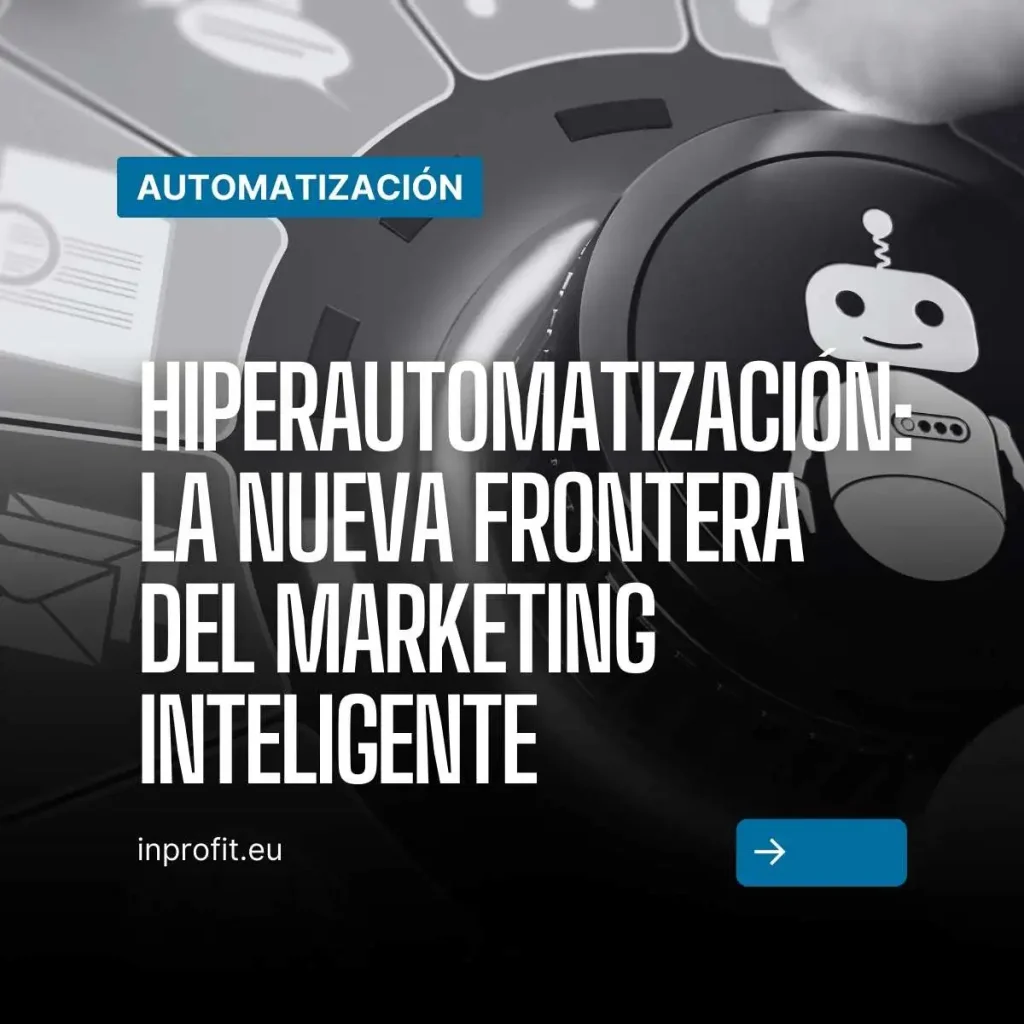Hyper-automation is emerging as the rocket that propels marketing into a new galaxy. This evolution of automation combines artificial intelligence (AI)machine learning and robotic process automation (RPA) to create ultra-intelligent marketing processes that not only save time, but anticipate desires and optimize results in real time. Ready to explore how hyper-automation is redefining the future of marketing? Let’s blast off!
Why does hyper-automation change the rules of the game?
Hyper-automation goes beyond traditional automation. It’s not just about scheduling emails or social media posts, but orchestrating entire marketing ecosystems with almost supernatural precision. By integrating AI, machine learning and RPA, hyper-automation enables brands to manage omnichannel campaigns, personalize experiences at scale and optimize every interaction in real time.
Imagine a system that not only sends a personalized email, but adjusts its tone, design and timing based on the consumer’s emotions and behaviors, all without human intervention. This is hyper-automation: a symphony of data and technology that turns marketing into a seamless, predictive experience.
The technological arsenal: The weapons of Hyper-automation
Hyper-automation relies on a powerful trio of technologies working together to transform marketing:
1. Artificial Intelligence: The Strategic Brain
AI analyzes large volumes of data to identify patterns and predict behaviors. For example, platforms such as Salesforce Einstein use AI to segment audiences with surgical precision, recommending products based on consumers’ subconscious preferences.
2. Machine Learning: The Tireless Learner
Machine learning allows systems to evolve with every interaction. A Google Ads campaign can be automatically optimized to maximize clicks, adjusting bids and keywords in real time based on performance data.
3. Robotic Process Automation (RPA): The Relentless Enforcer
RPA automates repetitive tasks such as database management, publication scheduling or reporting. For example, tools such as UiPath can integrate data from multiple platforms (CRM, social media, e-commerce) into a single automated flow.
How hyper-automation dominates omnichannel campaigns
In modern marketing, consumers interact with brands through multiple channels: social media, email, apps, websites and more. Hyper-automation acts like a conductor, ensuring that each channel hits the perfect note at the exact right time.
- Mass personalization: Hyper-automation allows unique messages to be sent to millions of users. For example, Amazon uses AI algorithms to recommend products based on browsing history, purchases and even the time a user spends looking at an item.
- Real-time optimization: Tools such as Adobe Experience Cloud dynamically adjust ads based on user behavior, changing colors, text or CTAs to maximize conversions.
- Seamless integration: Platforms such as Zapier or Microsoft Power Automate connect disparate tools (CRM, email, analytics) to create seamless workflows.
One success story is Netflix, which uses hyper-automation to personalize movie covers according to the tastes of each user, increasing viewing time by 20% according to internal studies.
The superpower that transforms businesses
Adopting hyper-automation is like giving your marketing team an Iron Man suit: power, precision and speed. These are the superpowers it brings:
- Efficiency: Automate repetitive tasks, freeing your team to focus on creative strategy. A campaign that used to take weeks can be designed in days.
- Personalization: Create unique experiences for each consumer, from emails to ads, without sacrificing speed or resources.
- Out-of-this-world predictions: Anticipates trends and behaviors, allowing brands to stay one step ahead of the competition.
- Stellar ROI: Gartner studies estimate that companies that implement hyper-automation can reduce operating costs by up to 30% while increasing conversions.
Automation challenges
Like any unexplored frontier, hyper-automation has its challenges. Navigating these shadows requires strategy and care:
- The cost: Implementing hyper-automation tools, such as RPA or AI platforms, requires a significant upfront investment in software and training.
- The Data Ethics Dilemma: Hyper-personalization relies on large amounts of data, which raises privacy concerns. Brands must comply with regulations such as GDPR and be transparent with consumers.
- Risk of dehumanization: An excessive focus on automation can cause campaigns to lose the human touch. Balancing technology with creativity is key.
- Stellar learning curve: Teams need training to master tools like UiPath or Salesforce Einstein, which can delay initial adoption.

Pioneers of the future: Examples of action
Leading brands are already exploring this new frontier. Here are some examples:
- Amazon: Its recommendation engine, powered by AI and machine learning, generates 35% of its sales by suggesting personalized products in real time.
- Coca-Cola: Uses RPA to automate inventory management and advertising campaigns, integrating data from multiple global markets in minutes.
- Spotify: Combines machine learning and AI to create personalized playlists such as Discover Weekly, increasing user retention by 25%.
These cases demonstrate how hyper-automation not only optimizes processes, but also creates experiences that deeply connect with consumers.
Heading to 2025: Trends that will redefine Hyperautomation
The future of hyper-automation in marketing is bright, with trends that promise to take it to new heights:
- Advanced Conversational AI: AI-enabled chatbots will evolve to handle complex interactions, from customer support to personalized sales.
- Edge Computing: Processing real-time data on local devices will improve the speed of omnichannel campaigns.
- Hyper-automation with 5G: Ultra-fast connectivity will enable instant updates in global campaigns.
- Integration with Metaverse: Brands will use hyper-automation to create personalized experiences in 3D virtual environments.
How to start implementation?
Ready to explore this new frontier? Follow these steps to integrate hyper-automation into your marketing strategy:
- Assess your needs: Identify repetitive processes that can be automated, such as social media management or data analysis.
- Choose the right tools: Invest in platforms such as Salesforce, UiPath or Adobe Experience Cloud according to your budget and objectives.
- Train your team: Train your employees in AI, RPA and data analytics to maximize the potential of the tools.
- Test and scale: Start with a pilot campaign, measure results and expand hyper-automation to other channels.
- Monitor ethics: Make sure you comply with privacy regulations and maintain transparency with consumers.
IA Marketing
Hyper-automation is not just a trend, it’s the new frontier of intelligent marketing. By combining AI, machine learning and RPA, brands can create omnichannel campaigns that are not only efficient, but deeply personalized and predictive. From optimizing ads in real time to anticipating consumer desires, this technology is redefining how we connect with audiences.
Are you ready to take off into smarter, more efficient marketing? Hyper-automation is the fuel you need to conquer the marketing cosmos in 2025.



